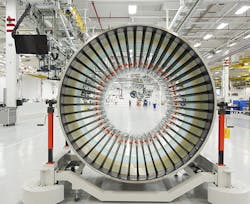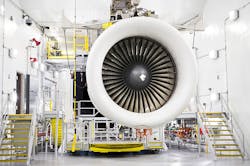Pratt & Whitney Builds for the Future
The future of jet engine manufacturing at Pratt & Whitney is on display at its Middletown, Conn., production facility. In February, the company unveiled a new horizontal engine assembly line that moves the huge aircraft engines through the manufacturing process. It’s part of a $1 billion investment in new technology that Pratt & Whitney is making to enhance its competitiveness in what is sure to become an increasingly crowded global market.
The horizontal assembly line will be used to manufacture Pratt & Whitney’s PurePower PW1100G-JM engine for the Airbus A320neo. The company also upgraded its production facilities for the F135 engine used in the F-35 Lightning II Joint Strike Fighter.
“There is a lot going on in our sector and definitely a lot going on at Pratt & Whitney,” says Joe Sylvestro, vice president of Manufacturing Operations. In fact, he sees his job as helping lead a transformation of the 90-year-old company to become “the business that we need for the future.”
Indeed, in an article for Aviation Week, Tom Captain of Deloitte noted that the industry expects to produce 30,000 commercial jets over the next 20 years. In February, Airbus announced plans to increase its monthly production target of A320 jets to 50 in 2017 from 42 currently. Last October, Boeing said it would increase production of its mainstay 737 commercial jet to 52 a month in 2018 from the 42 it was building in 2014.
Pratt & Whitney, a unit of United Technologies (IW 500/19), has contributed to this “significant boom” in aircraft production, says Sylvestro, by developing its Geared Turbofan jet engines. The company says the new engines reduce fuel use by 15%, noise by 75% and carbon emissions by low double digits. Those performance improvements, he says, “have made the business case for airlines to buy new aircraft much more favorable.”
Sylvestro emphasizes that the changes Pratt & Whitney is making in manufacturing are not simply a matter of adding tooling to increase production, which is expected to double by 2020. Instead, he says, the company has taken a longer view of its competitive situation and is retooling its manufacturing and supply chain so that “we are in a position to compete globally for a long time to come.”
Just as its engines are providing important performance advantages, Sylvestro says the same is true of the manufacturing technology it is purchasing.
“The machining equipment available today versus 10 to 15 years ago offers opportunities for productivity,” he says. “They are more programmable today, more accurate and the information that comes off the new equipment allows us to react more quickly. We are able to control the manufacturing processes that much better.”
The moving engine production line, Sylvestro notes, shifts from the discrete fixed tooling of the past and substitutes an overhead carriage system that moves the engines along at intervals based on the content of the work and how the line has been synced. By having the overhead hangers, the system frees up valuable floor space.
Ergonomics on the line are greatly improved. The engines can be adjusted vertically for shorter or taller employees and also rotated. “Once you log onto the job, it will remember your preferred working height and move the work to your height,” Sylvestro notes.
The system also reduces material handling because parts are brought to the assembly line and added directly to the engine rather than requiring the use of transfer fixtures. Sylvestro says this should not only reduce labor but save on space and improve quality because it reduces the opportunities to damage parts.
Pratt & Whitney has been able to draw largely on its existing factories and skilled employees as it begins its production ramp-up. As legacy engine programs retire, Sylvestro notes, the company can apply that manufacturing capacity and personnel to the new programs.
The company is also bringing a well-established supply base to these new programs, even as it expands its global supply chain. Pratt & Whitney has used a series of large meetings to communicate with suppliers about the company’s plans and current status for its engine programs. “We have senior leadership in front of them and we make it clear we are investing internally and they should as well,” he says.
Pratt & Whitney requires suppliers to submit a plan to demonstrate that they are ready to produce the parts the company needs. It also sends teams to supplier’s worksites to check on their “industrial readiness.” He explains, “In choosing them as a supplier, they have shown they have the capability but we want to see for ourselves. It definitely requires an intimate understanding of your network.”
Creating an Effective Team
While Pratt & Whitney offers some of the most attractive jobs available in manufacturing, the company is working on several fronts to ensure that it will continue to have the talent and skills it needs. It partners with a variety of community colleges to develop technical training programs, providing them equipment and funding. At Pratt & Whitney’s factory in North Berwick, Maine, the company works with York County Community College to offer an apprenticeship program. Students split their time each week between 20 hours in the classroom and 20 hours in a series of factory jobs where they learn different aspects of the operation.
Sylvestro says the company also makes an effort to recruit members of the military who are coming off their tours.
“They were in aircraft maintenance areas. They come out well-trained, mature and disciplined. They are just fantastic fits for the types of jobs that we have,” he says.
Sylvestro is keenly aware that Pratt & Whitney is a global company and one that must compete in a global marketplace. “The Chinese government is working very hard on developing not only their own aircraft but their own designed, developed and certified jet engines,” he points out.
To foster competitive success, Sylvestro adheres to a number of management tenets. He believes in developing a strong team and having them where possible own the direction of the operation. Pratt & Whitney is a large organization and good decisionmaking, he says, relies on open communication.
If you want information, you have to create an environment where information flows."
—Joe Sylvestro
“If you want information, you have to create an environment where information flows,” he says. “If people are too formal or afraid to say what they are thinking, that information doesn’t flow.”
Sylvestro also acknowledges the need to “drive every day” to remain competitive, but he says that push for production and improvement must be accompanied with respect. “Everyone gets paid” at Pratt & Whitney, he notes wryly, but what really makes employees committed to the company’s goals is the feeling that they are respected and listened to. There is also a fundamental requirement that all employees obey laws and regulations, and that the company operates safely, he emphasizes.
Global competitiveness also means the organization has no room for “sacred cows,” Sylvestro says. Businesses have to be comfortable with assessing what they are doing, make changes if needed and then pursue the new course.
“We have to have a propensity for change,” he explains. “Everything has to be on the table. I’m not saying you continuously reevaluate but the clock speed of business today is very, very high.”
How do you move quickly while having a clear sense of where you want the business to head? Sylvestro says it is important to keep the essentials of the business in mind.
“We are a jet engine manufacturer. We want to sell to all the customers we are allowed to and be the most competitive company to do that.”
Sylvestro’s focus on manufacturing competitiveness took on a broader dimension recently when he was appointed to the Commerce Department’s Manufacturing Council. One thing he hopes to promote during his tenure is the importance of the aerospace sector to the U.S. economy. He notes that it is an innovative industry that provides good-paying, high-tech jobs. It also supports a large supply chain, with technology capabilities that provide a competitive edge for U.S. manufacturing.
The Manufacturing Council can also help with ongoing efforts to improve the perception of manufacturing in the U.S. and attract talented young people to the industry, Sylvestro believes. They may even embark on a journey similar to his. As an engineering student, he dreamed of designing jet engines. After a career at Pratt & Whitney that led him through a variety of responsibilities from Singapore to Connecticut, he gives high marks to the part of his career where he now is in charge of building jet engines.
“It is a very satisfying area to work in. It is addicting actually. Once you are in the life, it is hard to get out, I think.”
About the Author
Steve Minter
Steve Minter, Executive Editor
Focus: Leadership, Global Economy, Energy
Call: 216-931-9281
Follow on Twitter: @SgMinterIW
An award-winning editor, Executive Editor Steve Minter covers leadership, global economic and trade issues and energy, tackling subject matter ranging from CEO profiles and leadership theories to economic trends and energy policy. As well, he supervises content development for editorial products including the magazine, IndustryWeek.com, research and information products, and conferences.
Before joining the IW staff, Steve was publisher and editorial director of Penton Media’s EHS Today, where he was instrumental in the development of the Champions of Safety and America’s Safest Companies recognition programs.
Steve received his B.A. in English from Oberlin College. He is married and has two adult children.


